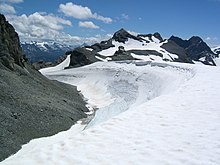Windkolk

Dirndlkolk in the Hallstätter Glacier in the Dachstein massif , often referred to as the largest Windkolk in the Eastern Alps
|
A wind kolk (also glacier kolk) is a free space in the glacier or snow created by strong wind action on an obstacle, for example a boulder . This requires strong, evenly blowing winds ("prevailing winds"). The snow is constantly being eroded by the jet effect. Such structures can also be observed on artificial obstacles such as buildings or fences. The effect is also used in avalanche barriers ; in part, it is consciously exploited by means of scour panels for drift barriers.
A calculation of the development process seems largely impossible so far; the problem resembles that of corneal formation . Attempts in this regard were first carried out around 1920 by Wilhelm Welzenbach . Significant research was carried out on the plains of Wyoming by Ronald D. Tabler in 1978 . Roland Meister and Paul Föhn tried with little success to adapt his results for modeling the cornice formation and the snow distribution in avalanche start zones.
Structures of the same kind can also arise in sandy terrain and are sometimes referred to there as wind kolk.
See also
Individual evidence
Web links
- Alpine Club Freistadt: Tips & tricks, avalanche danger
